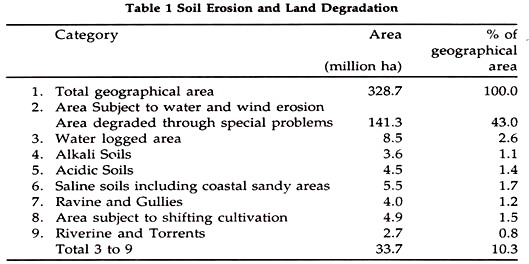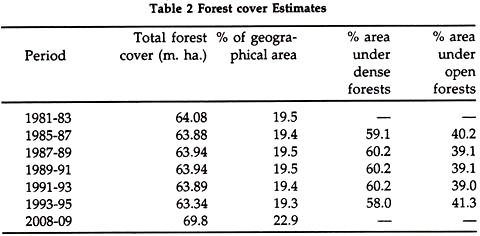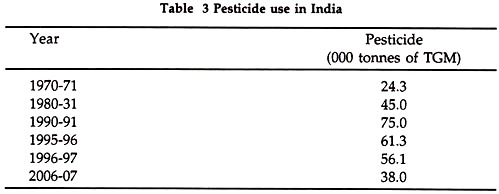The following points highlight the five main impacts of agriculture on environment. The impacts are:- 1. Degradation of Land 2. Deforestation 3. Biodiversity 4. Pest Problem 5. Disposal of Industrial & Agricultural Wastes.
Impact # 1. Degradation of Land:
The degradation of land in one form or the other is matter of serious concern endangering sustainability of agriculture. Landslides caused by rains and flowing water in hilly areas and deforestation, overgrazing and faulty cultural practices in the forest and other plain areas expose the soil to water and wind erosions. As may be seen from Table. 1, out of total geographical area, 141.3 million hectare (10.3 per cent) area is subject to such water and wind erosions.
The waterlogging due to rising water table, particularly along the rivers, rendering soil unfit for cultivation, covers 8.5 million hectare land. Similarly, increased dependence on intensive agriculture and irrigation also resulted in salination, alkalination and water logging in the some irrigated area of the country.
Therefore apart from problem soils forming a significant part of the total area, the following are the kinds of land degradations taking place:
ADVERTISEMENTS:
(a) Deficiency of soil nutrients due to intensive cultivation.
(b) Imbalance in soil nutrients particularly the deficiency of micro- nutrients.
(c) Decline in the organic matter in the soil.
ADVERTISEMENTS:
(d) Deforestation and overgrazing of Pasteur’s causing exposure of soil to water and wind erosion.
(e) Decline in underground water due to over exhaustion for high water using crops, increase in cropping intensity and increase in cultivated area especially is northern part of the sweet water zone.
(f) Increase in water level in the cotton belt of north-western part of the country endangering then cultivation of cotton crop due to pumping out of brackish water resulting in accumulation of salts on earth surface. Further, the wet condition due to non-percolation of rain water attracts serious pests.
(g) High use of nitrogen and water have caused percolation of nitrogen up to water table thus polluting it even for human consumption.
Impact # 2. Deforestation:
ADVERTISEMENTS:
The forest cover estimates are given in Table 2.
The main reasons for decline in forest wealth are:
1. Increase in population resulting in more demand for fuel wood and timber.
3. Indiscriminate siting of development projects.
4. Forest fires.
5. The forest area in the recent past has not changed much because its diversion for non-forestry purposes has been more or less compensated by afforestation.
“The annual withdrawal of fuel wood is estimated at 235 million cubic meters against a sustainable capacity of about 48 million cubic meters. The annual demand for industrial wood is 28 million cubic meters against the production capacity of 12 million cube meters. The area affected by forest fire ranges from 33 percent in West Bengal to 99 percent in Manipur.”
Impact # 3. Biodiversity:
India is a country with wide variety of agro-climatic conditions which harbour a wide variety of animals and plants. According to an estimate, India ranks 10th in the World and 4th in Asia in terms of plant diversity. As agriculture is becoming more and more commercialized, a number of plant and animal species are becoming extinct.
ADVERTISEMENTS:
The crops showing high profits are covering more area while the less profitable ones are rapidly declining, creating a number of environmental problems. The depletion of vegetative cover such as grass lands and forest tree species and similarly extinction of wild animals, birds and insects is matter of concern. According to another estimate, over 1,500 plant species, 79 mammals, 44 birds, 15 reptiles, 3 amphibians and several insects are listed as endangered.
Impact # 4. Pest Problem:
With the shift in crop pattern, increase in area under irrigation and higher cropping intensity, the pest problem has become very severe. The seriousness of pests has further increased by way of indiscriminate and increased use of pesticides.
The predatory birds and insect population has dwindled at a sharp rate causing lack of natural control of pests. The direct effect of high use of dangerous pesticides is on human and animal health. A large variety of cases of residual effect of pesticides and intake by human and animals have created health hazards.
ADVERTISEMENTS:
It is clear from table 3 that the use of pesticides increased at a fast rate in the country. It was 24.3 thousand tonnes of Technical Grade Material in 1970- 71 which increased to 75.0 thousand tonnes in 1990-91, thereafter it started falling, touching a level of 56.1 thousand tonnes in 1996-97 and 38 thousand tonnes in 2006-07. The recent decline in the pesticide use is due to increasing awareness among producers and consumers about the ill-effects of pesticides.
Impact # 5. Disposal of Industrial & Agricultural Wastes:
The use of by-products such as paddy straw and rice husk has not been made properly. The burning of such by-products creates increase in carbon dioxide and carbon-monoxide in the atmosphere resulting in respiratory problems for animals and human beings. There is need for recycling the agricultural wastes by having enterprises like dairy, poultry, fishery etc., processing of by-products and ploughing in the field as organic matter.
The mechanisation of agriculture require various energy resources such as diesel, electricity, petrol etc. Moreover, higher use of fertilizers as well, has negative impact on the ecology of the country by air pollution. Affluent water, smoke and un-degradable solid waste from industries and domestic uses have also been responsible for toxicity in plant and animal particularly fish and unbalanced soil nutrients which needs to be checked through treatment plants.


